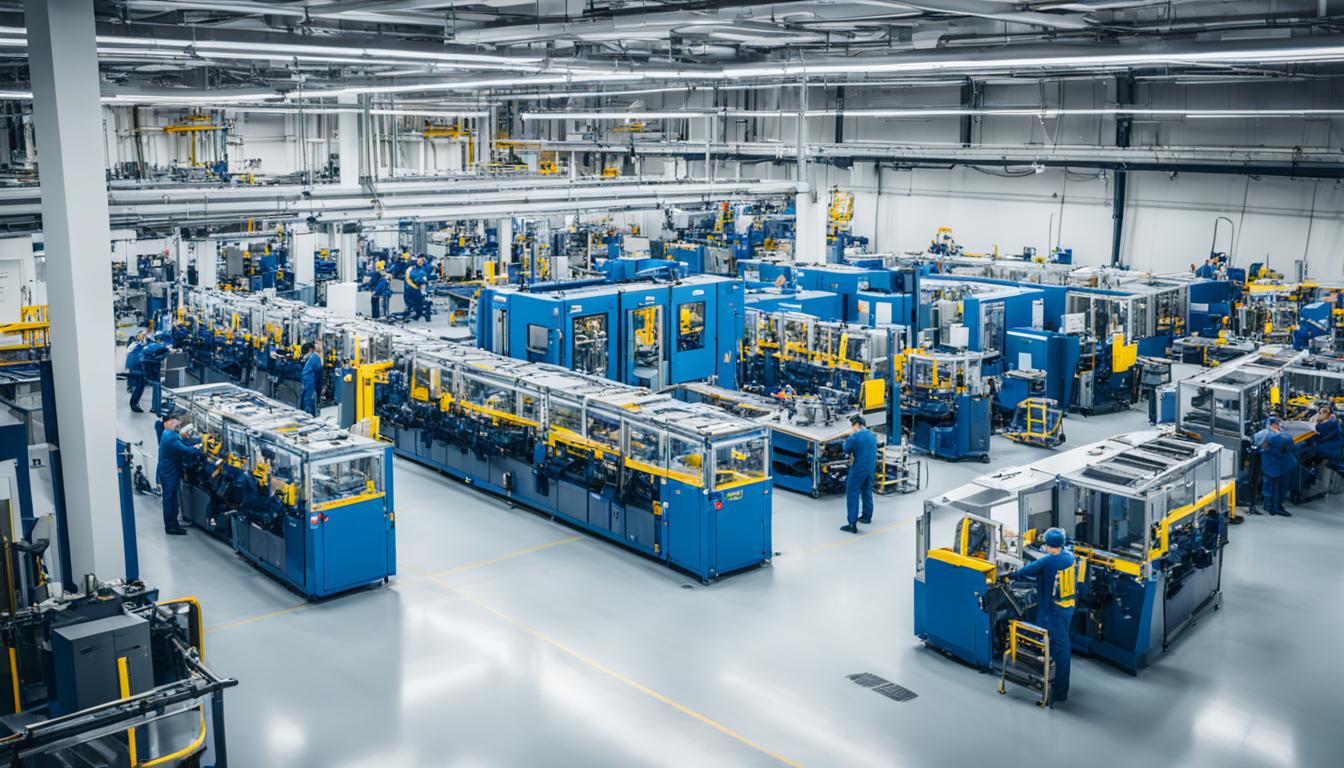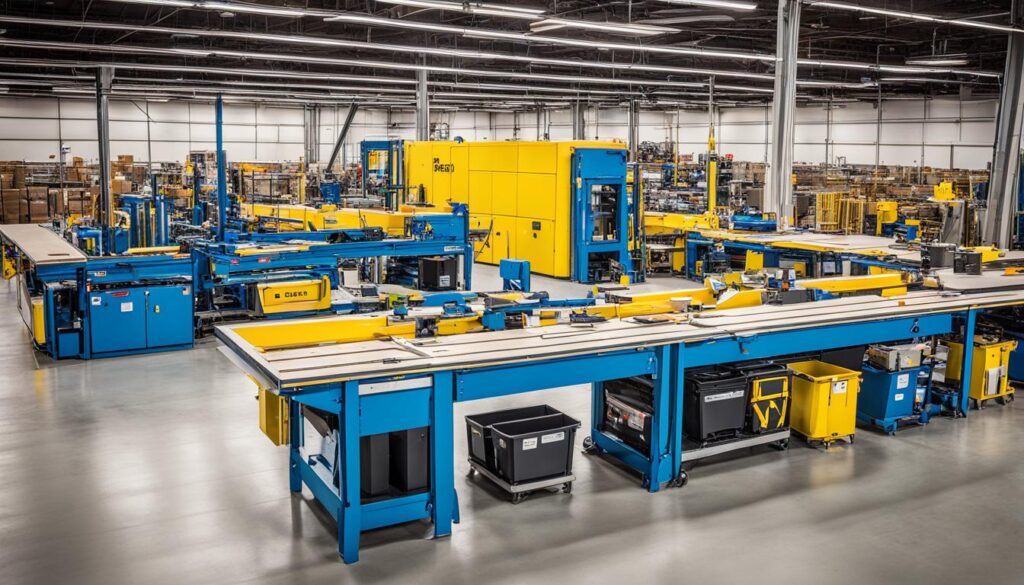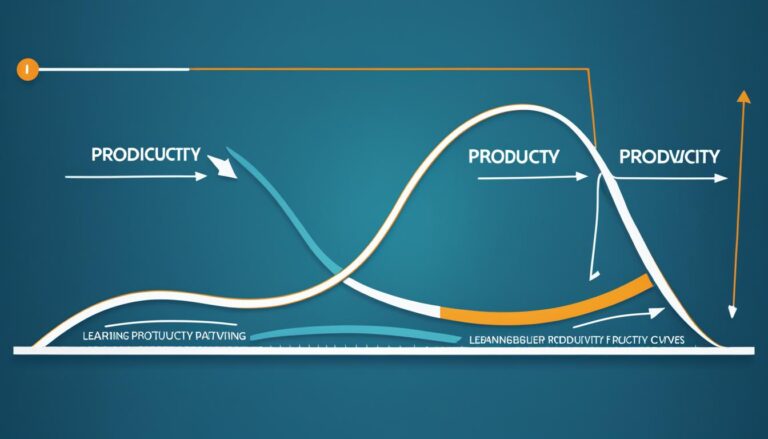Elevate Your Factory’s Output: Improving Productivity in Manufacturing

Are you looking to boost your manufacturing output and enhance your factory’s productivity? The key lies in improving productivity in manufacturing, optimizing processes, and implementing lean manufacturing techniques. But where do you start, and how do you ensure your efforts yield the desired results?
Let’s explore eight strategies that can help you improve productivity in manufacturing and take your factory’s output to new heights. From leveraging IIoT for real-time data collection to eliminating the six big losses, these approaches will revolutionize your operations and drive efficiency.
But first, think about this: What if you could significantly increase your manufacturing output without adding extra resources or extending the working hours? Sounds too good to be true? Read on to discover the untapped potential within your factory and unlock the secrets to skyrocketing productivity.
Key Takeaways:
- Implement lean manufacturing techniques to optimize production processes.
- Utilize IIoT for real-time data collection and analysis.
- Ensure machines are running properly with predictive maintenance practices.
- Automate data collection and reporting to reduce errors and streamline processes.
- Conduct a Pareto analysis to identify critical improvement areas.
Utilize IIoT for Real-Time Data Collection
The integration of the Industrial Internet of Things (IIoT) into manufacturing settings revolutionizes data collection and analysis, enabling real-time insights into productivity and efficiency. By harnessing the power of IIoT, manufacturers can capture and monitor data from smart equipment and machinery, facilitating immediate decision-making and performance optimization.
Real-Time Data Collection for Enhanced Manufacturing Efficiency
With IIoT, manufacturers can access real-time data on equipment performance, production output, and resource utilization. This valuable information allows for proactive decision-making and efficient resource allocation, driving manufacturing efficiency to new heights.
One of the key benefits of IIoT is its ability to track Overall Equipment Effectiveness (OEE), a vital metric for measuring and improving manufacturing efficiency. By collecting real-time data on machine availability, performance, and quality, manufacturers can gain comprehensive insights into production effectiveness and identify areas for improvement.
Furthermore, historical data analysis facilitated by IIoT enables manufacturers to identify patterns and trends over time. By analyzing historical data, manufacturers can uncover root causes of inefficiencies, identify opportunities for process optimization, and make data-driven decisions to enhance productivity.
Advantages of Real-Time Data Collection with IIoT
Utilizing IIoT for real-time data collection revolutionizes the manufacturing landscape, offering several advantages:
- Improved Decision-Making: Real-time data provides manufacturers with up-to-the-minute information, allowing for faster and more accurate decision-making to address productivity gaps and optimize resource utilization.
- Reduced Downtime: By monitoring equipment performance in real-time, manufacturers can detect issues before they escalate into costly breakdowns, enabling proactive maintenance and minimizing production downtime.
- Enhanced Predictive Capabilities: Real-time data collection enables manufacturers to predict potential equipment failures and take preventive measures to avoid disruptions, improving overall equipment reliability and longevity.
- Streamlined Operations: Automation of data collection eliminates the need for manual record-keeping, reducing human error and freeing up valuable time for employees to focus on critical tasks.
Image: IIoT in Manufacturing

By embracing IIoT and leveraging its capabilities for real-time data collection and analysis, manufacturers can unlock new levels of manufacturing efficiency and productivity. The power of IIoT lies in its ability to provide actionable insights based on real-time data, enabling manufacturers to make informed decisions and drive continuous improvement in their operations.
Ensure Machines Are Running Properly With Predictive Maintenance
Maintaining optimal machine performance is crucial for improving productivity in your manufacturing operations. By implementing predictive maintenance practices, you can proactively address machine maintenance needs and avoid unplanned downtime and production stops. Predictive maintenance involves real-time monitoring and analysis of machine data, allowing you to identify potential failures before they occur.
By ensuring your machines are running properly, you can optimize your production processes, minimize downtime, and improve Overall Equipment Effectiveness (OEE). This predictive approach to maintenance helps you reduce the risk of costly repairs and ensures that your equipment is operating at its peak performance levels.
With predictive maintenance, you can leverage advanced analytics and AI-powered algorithms to accurately forecast potential machine failures based on historical and real-time data. By identifying patterns and trends, you can schedule maintenance activities in advance, ensuring that critical components are repaired or replaced before they cause production disruptions.
Benefits of Predictive Maintenance
- Minimize unplanned downtime: By predicting and preventing machine failures, you can significantly reduce unplanned downtime, which can disrupt your production schedule and impact overall productivity.
- Optimize maintenance schedules: With real-time data analysis, you can optimize your maintenance schedules and allocate resources efficiently, reducing unnecessary maintenance activities and maximizing operational efficiency.
- Extend equipment lifespan: Predictive maintenance allows you to identify and address potential issues early, helping you extend the lifespan of your machinery by preventing major breakdowns and reducing the need for costly replacements.
- Improve safety: Properly maintained machines are less likely to malfunction, reducing the risk of accidents and ensuring a safer working environment for your employees.
Implementing predictive maintenance not only helps you reduce downtime and optimize production processes but also enhances the overall reliability and performance of your machines. By embracing this proactive maintenance strategy, you can drive continuous improvement, increase your production output, and achieve better manufacturing efficiency.

| Benefits of Predictive Maintenance | Key Focus Areas |
|---|---|
| Minimize unplanned downtime | Real-time data analysis |
| Optimize maintenance schedules | Accurate forecasting |
| Extend equipment lifespan | Advanced analytics |
| Improve safety | Preventive measures |
Consider Automating Data Collection and Reporting
Automation has become a powerful tool for improving manufacturing efficiency and optimizing production processes. One area where automation can have a significant impact is in data collection and reporting. By embracing data collection automation and reporting automation, manufacturers can streamline operations, enhance decision-making, and ultimately improve overall productivity.
Traditionally, data collection and reporting have been manual and time-consuming processes, often prone to human error. Manual data entry and report generation not only require significant resources but also introduce the risk of inaccuracies and delays. However, by leveraging automation technology, manufacturers can eliminate these inefficiencies and unlock a range of benefits.
Data collection automation enables real-time data capture from various sources, including machines, sensors, and production lines. With automated systems in place, manufacturers can collect and analyze data seamlessly, providing accurate and up-to-date information for decision-making. Instead of relying on manual data entry, which can be tedious and error-prone, automated data collection ensures data accuracy and reliability.
Moreover, reporting automation eliminates the need for manual report generation by generating reports automatically based on pre-defined criteria. By automating report generation, manufacturers can save time, reduce paperwork, and improve operational efficiency. With automated reporting, managers and stakeholders can access timely and relevant information, enabling them to make informed decisions and take necessary actions to optimize the production process.
Automating data collection and reporting also creates a better working environment for the manufacturing team. By eliminating the repetitive and mundane task of manual data entry, employees can focus on more strategic and value-added activities. This not only enhances job satisfaction but also allows for increased productivity and innovation within the workforce.
To visualize the impact of data collection and reporting automation, let’s take a look at the following table:
| Manual Data Collection and Reporting | Automated Data Collection and Reporting |
|---|---|
| Time-consuming and prone to errors | Real-time and accurate data collection |
| Manual report generation | Automatic report generation based on pre-defined criteria |
| Paperwork and administrative burden | Reduced paperwork and improved efficiency |
| Delayed access to relevant information | Timely and accessible data for decision-making |
As the table highlights, automating data collection and reporting brings numerous advantages to manufacturing operations, from eliminating errors and paperwork to enabling real-time decision-making. By embracing automation, manufacturers can optimize their production processes, improve manufacturing efficiency, and drive overall productivity.
Next, we will explore the importance of conducting a Pareto analysis using the 80/20 rule for further production optimization and efficiency improvement.
Conduct a Pareto Analysis Using the 80/20 Rule
The Pareto analysis, based on the 80/20 rule, is a valuable tool for identifying and addressing productivity issues in manufacturing. By conducting a Pareto analysis, you can determine the factors that have the greatest impact on production efficiency. This analysis helps allocate resources and focus improvement efforts on the critical issues that contribute to the most significant losses.
The 80/20 rule, also known as the Pareto principle, states that roughly 80% of effects come from 20% of causes. In the context of manufacturing, it means that a small number of factors are responsible for the majority of problems or inefficiencies. By addressing these top 20% of factors causing 80% of problems, you can optimize your production processes and improve overall efficiency.
To conduct a Pareto analysis, follow these steps:
- Identify the problems or inefficiencies affecting your production process.
- Collect data on the frequency or impact of each identified issue.
- Rank the issues in descending order of their frequency or impact.
- Calculate the cumulative percentage of the total issues.
- Plot the issues on a Pareto chart, with the most significant issues on the left.
- Analyze the chart to identify the critical few issues that contribute to the majority of problems.
- Focus your improvement efforts on addressing these critical issues.
Here is an example of a Pareto chart:
| Problem | Frequency | Cumulative Percentage |
|---|---|---|
| Equipment breakdowns | 35 | 35% |
| Material shortages | 20 | 55% |
| Inefficient workflow | 15 | 70% |
| Quality defects | 10 | 80% |
| Other issues | 20 | 100% |
From the Pareto chart, you can see that equipment breakdowns, material shortages, and inefficient workflow account for the majority of problems. By addressing these issues, you can significantly improve production efficiency.
Conducting a Pareto analysis using the 80/20 rule enables you to prioritize your problem-solving efforts and allocate resources effectively. By focusing on the critical few factors that contribute to the majority of problems, you can optimize your production processes, improve efficiency, and achieve sustainable productivity improvements.
Account For All Production Stops
To improve your factory’s productivity and optimize production processes, it is crucial to account for all production stops and understand the reasons behind them. By closely monitoring and analyzing production stoppages, you can identify patterns and address the underlying issues causing these interruptions.
Production stops can have a significant impact on your factory’s efficiency, leading to downtime and decreased production output. By proactively examining when and why these stops occur, you can implement targeted solutions to minimize their occurrence and prevent future disruptions.
Understanding the root causes of production stops allows you to develop problem-solving strategies that address specific issues. By focusing on process optimization and problem-solving, you can eliminate bottlenecks, reduce downtime, and improve overall efficiency.
By streamlining your production processes and minimizing production stops, you can enhance your factory’s productivity and achieve higher production efficiency. This proactive approach helps you maximize output and ensure optimal utilization of your resources.

| Benefit | Actions |
|---|---|
| Identification of Production Stop Patterns | Analyze production stop data to identify recurring patterns and understand the common reasons behind these stops. |
| Root Cause Analysis | Conduct root cause analysis to determine the underlying issues causing production stops. |
| Targeted Problem-Solving | Develop targeted problem-solving strategies to address specific issues contributing to production stops. |
| Process Optimization | Optimize your production processes to minimize production stops and improve overall efficiency. |
| Continuous Improvement | Implement a culture of continuous improvement to prevent future disruptions and enhance productivity. |
Eliminate the Six Big Losses
In the pursuit of lean manufacturing and production optimization, it is crucial to address the Six Big Losses that contribute to waste and inefficiency in factories. By targeting and eliminating these sources of loss, manufacturers can significantly improve productivity and achieve higher levels of efficiency.
- Planned Stops: These are scheduled downtime periods for maintenance, changeovers, or preventive measures. While planned stops are necessary, they should be minimized to avoid excessive production interruptions and optimize overall efficiency.
- Unplanned Stops: Unforeseen equipment breakdowns, power outages, or other unforeseen circumstances can lead to unplanned stops. By implementing proactive maintenance strategies and investing in reliable machinery, manufacturers can reduce the frequency and duration of unplanned stops, ensuring smoother production flow.
- Micro Stops: Brief equipment malfunctions or minor interruptions may seem insignificant individually, but they add up over time. By identifying the root causes of micro stops and implementing corrective measures, manufacturers can eliminate these small disruptions and prevent them from impacting overall production efficiency.
- Slow Cycles: Inefficiencies in the production process can lead to slow cycles, where machines are not operating at their optimal speed. By analyzing and optimizing production workflows, manufacturers can identify bottlenecks and implement solutions to increase the pace of production, improving overall efficiency.
- Start-Up Rejects: Defective products or rejects that occur during the start-up phase can result in wasted materials, time, and effort. By carefully planning and executing start-up processes, manufacturers can reduce the number of rejects, minimize waste, and improve efficiency right from the beginning of the production cycle.
- Production Rejects: Rejects or defects that occur during regular production can lead to wasted time, resources, and lower productivity. By implementing quality control measures, refining production techniques, and investing in employee training, manufacturers can reduce the occurrence of production rejects, improving efficiency and overall product quality.
Eliminating the Six Big Losses requires a holistic approach that addresses each area of waste individually. By implementing lean manufacturing principles, conducting root cause analyses, and continuously optimizing production processes, manufacturers can streamline operations, reduce waste, and improve overall productivity.

| Loss Category | Impact on Efficiency | Elimination Strategies |
|---|---|---|
| Planned Stops | Interrupts production flow and decreases overall efficiency. | Optimize maintenance schedules, improve changeover procedures, and reduce planned downtime. |
| Unplanned Stops | Causes unexpected delays and hampers productivity. | Implement predictive maintenance, invest in reliable equipment, and establish contingency plans. |
| Micro Stops | Cumulative impact on productivity despite being individually small. | Identify and address root causes of equipment malfunctions, improve equipment reliability, and optimize processes. |
| Slow Cycles | Reduces production output and leads to inefficiencies. | Analyze production workflows, identify bottlenecks, optimize equipment settings, and improve process efficiency. |
| Start-Up Rejects | Wastes time, materials, and effort at the beginning of production. | Develop comprehensive start-up procedures, conduct thorough equipment checks, and ensure proper training. |
| Production Rejects | Results in rework, wastes resources, and lowers productivity. | Implement robust quality control measures, enhance employee training, and continuously improve processes. |
Conclusion
Improving productivity in manufacturing is the key to unlocking your factory’s full potential. By implementing cutting-edge techniques and strategies, you can enhance manufacturing efficiency, optimize production processes, and ultimately boost your output. One effective approach is to utilize Industrial Internet of Things (IIoT) technology for real-time data collection, providing valuable insights into productivity and efficiency. By leveraging IIoT, you can track Overall Equipment Effectiveness (OEE), analyze historical data, and make data-driven decisions. This eliminates manual data gathering, reduces errors, and improves manufacturing efficiency.
Another crucial aspect of productivity improvement is predictive maintenance. By monitoring machine performance in real-time, you can identify potential failures and proactively address maintenance needs. This minimizes unplanned downtime, optimizes production processes, and improves OEE. Additionally, automating data collection and reporting streamlines processes, reduces errors, and provides accurate information for decision-making. By replacing manual tasks with automation, you can improve manufacturing efficiency and create a better working environment.
Conducting a Pareto analysis allows you to identify critical factors that impact production efficiency. By addressing the top 20% of issues causing 80% of problems, you can prioritize improvement efforts and optimize production processes. It is also essential to account for all production stops and understand the reasons behind them. By closely monitoring and analyzing these stoppages, you can identify patterns and implement targeted solutions to minimize downtime and optimize efficiency.
Additionally, eliminating the Six Big Losses, which include Planned Stops, Unplanned Stops, Micro Stops, Slow Cycles, Start-Up Rejects, and Production Rejects, is crucial for waste reduction and improving productivity. By addressing and eliminating each of these sources of waste, you can streamline production processes and enhance overall efficiency. It is important to continuously optimize production processes and embrace lean manufacturing techniques to elevate your factory’s output and achieve long-term success in the manufacturing industry.
FAQ
What is lean manufacturing?
Lean manufacturing is an approach that focuses on streamlining production processes to minimize waste and maximize efficiency. It involves continuously identifying and eliminating non-value-added activities, reducing inventory levels, and optimizing workflow to improve overall productivity.
How can IIoT improve productivity in manufacturing?
The integration of the Industrial Internet of Things (IIoT) allows manufacturers to collect and analyze real-time data from smart equipment and machinery. This technology provides valuable insights into productivity and efficiency, enabling faster decision-making and optimization of manufacturing processes based on data-driven insights.
What is predictive maintenance, and how can it enhance productivity?
Predictive maintenance involves monitoring and analyzing machine data in real-time to identify potential failures before they occur. By proactively addressing maintenance needs, manufacturers can prevent unplanned downtime, optimize production processes, and improve Overall Equipment Effectiveness (OEE) for enhanced productivity.
How can automating data collection and reporting improve manufacturing efficiency?
Automating data collection and reporting replaces manual entry and eliminates paperwork, reducing errors and streamlining processes. Real-time data collection and analysis provide accurate and up-to-date information for decision-making, enabling manufacturers to optimize the production process, improve productivity, and create a better working environment for their team.
What is a Pareto analysis, and how can it help improve productivity?
A Pareto analysis uses the 80/20 rule to identify the factors that have the greatest impact on production efficiency. By addressing the critical issues contributing to the most significant losses, manufacturers can allocate resources effectively and focus improvement efforts to optimize production processes and enhance overall efficiency.
Why is it important to account for all production stops?
By closely monitoring and analyzing production stoppages, manufacturers can identify patterns and address the underlying issues causing interruptions. This proactive approach helps minimize downtime, optimize production processes, and improve overall efficiency by implementing targeted solutions and preventing future disruptions.
What are the Six Big Losses in lean manufacturing?
The Six Big Losses categorize major sources of waste in a factory, including Planned Stops, Unplanned Stops, Micro Stops, Slow Cycles, Start-Up Rejects, and Production Rejects. By eliminating these sources of waste, manufacturers can significantly improve productivity, streamline production processes, and enhance overall efficiency.
How can improving productivity benefit manufacturing operations?
Improving productivity in manufacturing leads to increased efficiency, reduced waste, and higher output. By implementing strategies such as lean manufacturing techniques, predictive maintenance, data automation, and waste reduction, manufacturers can optimize their operational efficiency, maximize productivity, and achieve long-term success in the industry.





